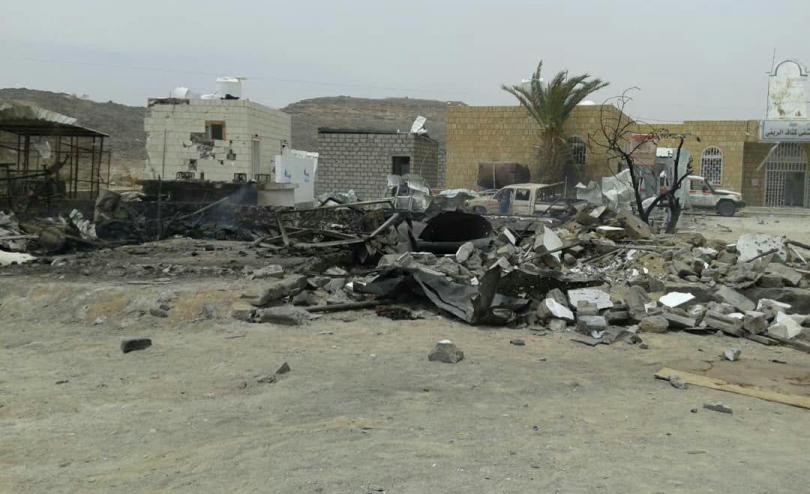Yemen: 85,000 children may have died from starvation since start of war

Urgent need to reach hundreds of thousands of severely malnourished children before it’s too late, warns Save the Children
SANAA, November 21 – An estimated 85,000 children under five may have died from extreme hunger or disease since the war in Yemen escalated, according to new analysis by Save the Children.
Using data compiled by the UN, Save the Children evaluated mortality rates for untreated cases of Severe Acute Malnutrition (SAM) in children under five years. Using a conservative estimate, the humanitarian aid agency discovered that approximately 84,701 children with SAM may have died between April 2015 and October 2018.[i]
After almost four years since the brutal conflict in Yemen escalated the UN says that up to 14 million people are at risk of famine. That number has increased dramatically since the Saudi and Emirati-led coalition imposed a month-long blockade of Yemen just over a year ago.[ii]
Since then, commercial imports of food through Hodeidah port have reduced by more than 55,000 metric tonnes a month. That’s enough to meet the needs of 4.4 million people, including 2.2 million children[iii]. Any further decline in imports could likely lead directly to famine.[iv]
Tamer Kirolos, Save the Children’s Country Director in Yemen, said:
“We are horrified that some 85,000 children in Yemen may have died because of extreme hunger since the war began. For every child killed by bombs and bullets, dozens are starving to death and it’s entirely preventable.[v]
“Children who die in this way suffer immensely as their vital organ functions slow down and eventually stop. Their immune systems are so weak they are more prone to infections with some too frail to even cry. Parents are having to witness their children wasting away, unable to do anything about it.
“Save the Children has provided food for 140,000 children and treated more than 78,000 children for malnutrition since the start of the crisis. Despite the challenges, we’re saving lives every day.”
Fighting, blockades and bureaucracy have forced Save the Children to bring vital supplies for the north of the country through the southern port of Aden. As a result, it can take up to three weeks for aid to reach people instead of the week it would take if Hodeidah port was fully operational.
Save the Children has also observed a dramatic increase in airstrikes on Hodeidah over recent weeks. Increased fighting has also been reported in Taiz, Saada and Sanaa.
Tamer Kirolos added:
“In the past few weeks there have been hundreds of airstrikes in and around Hodeidah, endangering the lives of an estimated 150,000 children still trapped in the city. Save the Children is calling for an immediate end to the fighting so no more lives are lost.
“We urgently need to get high-nutrient foods to the most vulnerable children in Yemen, some of whom are truly on the brink. Just £50 can feed a family of seven for a whole month. One child dying from starvation is one child too many.”
To donate to Save the Children’s Yemen response, please visit: https://donate.savethechildren.org/yemen
NOTES TO EDITORS:
- According to the UN an estimated 400,000 children are expected to suffer from severe acute malnutrition, the deadliest form of extreme hunger, during 2018. That’s 15,000 more than in 2017.
- Just over one year ago, the Saudi-led coalition closed off all access to the country, effectively sealing Yemen off from the outside world. Six weeks later the coalition announced ports would reopen temporarily, before claiming all sea, air and land ports were fully open from 16th April 2018. Dates from UN OCHA Yemen commodity tracker as of 4th October 2018
- Some restrictions to imports have nominally been lifted but authorities have announced new regulations will come into effect from 9th November, which the UN believes could cause imports of key food commodities and fuel to fall by half.[vi]
- Barriers to importing and distributing supplies contribute to and are compounded by a spiralling economic crisis that has seen the cost of food nearly double since the conflict escalated in 2015.
- Once aid supplies reach Yemen, armed checkpoints criss-cross the country, delaying distribution. Frequent attacks on food processing and distribution, including on a vegetable packing facility on 24thOctober when 21 civilians were killed, are making matters even worse. In one district alone there have been five attacks on vehicles transporting food in the last month.
- Save the Children has over 50 years of experience working in Yemen. Operational in the country since 1963, the charity was the first international aid group in Yemen. We work nationally and locally to promote and protect children’s rights, with programmes in education, protection, health, nutrition, sanitation, hygiene, livelihoods and food security. For more see here.
- Save the Children stands side by side with children in the toughest places to be a child. We do whatever it takes to make sure they survive, get protection when they’re in danger, and have the chance to learn. Together, we fight for children every single day.
[i] Based on an analysis of UNICEF/Nutrition Cluster data malnutrition estimates between 2015 and 2018, 1,314,679 children under the age of five in Yemen needed treatment for Severe Acute Malnutrition (SAM) between April 2015 and October 2018 (43 months). The estimate of 85,000 deaths represents the mid-point of an estimate range for mortality in cases of untreated SAM, based on four historical studies looking at the links between severe malnutrition and death and an average Middle Upper Arm Circumference (MUAC) of severely malnourished children in Yemen. The lowest level is 60,115 deaths, assuming a MUAC of 110mm. That rises to 109,288 when MUAC is assumed to be 106mm. The mid-point is 84,701 deaths from SAM between April 2015 and October 2018.
[ii] According to the WFP Yemen Country Brief, 6.8 million people were severely food insecure in September 2017
[iii] According to UNOCHA Yemen requires 350,000 MT of commercial food imports each month. On average, monthly food imports have been 55,808 MT lower since the blockade than before it was imposed. 55,808 is 16% of 350,000. The reduction in imports would therefore be enough to meet the needs of 16% of the population. World Bank data shows Yemen’s population as 27.58 million (2016). 16% is 4.4 million people. Based on the credible assumption that approximately half of Yemen’s population is under 18, 2.2 million of these people would be children.
[iv] Famine Early Warning System: Yemen Food Security Alert: October 24, 2018
[v] The latest UN verified figure for children killed directly by air strikes and fighting is 2,200
[vi] Under-Secretary-General for Humanitarian Affairs and Emergency Relief Coordinator, Mr. Mark Lowcock, Remarks to the Security Council on the Humanitarian Situation in Yemen, 23 October 2018




